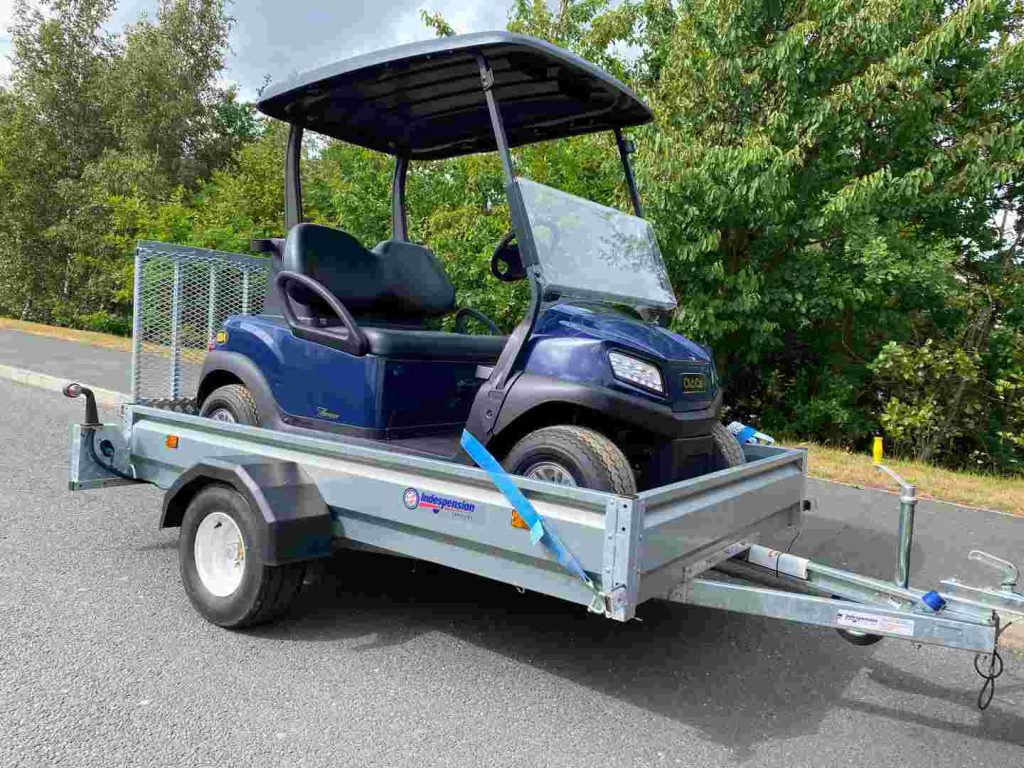8 Surprising Reasons Why Your Electric Golf Cart Isn’t Moving
An electric golf cart not moving could be due to a faulty solenoid or a dead battery. As a golf cart owner, a scenario where your electric golf cart doesn’t move can be frustrating and stressful.
There are several reasons why an electric golf cart might not move, and it’s essential to diagnose the problem accurately to fix it. One of the most common issues is a dead battery, which could happen when the battery loses power or when the battery terminals get corroded.
The solenoid, a device that regulates the flow of electricity to the golf cart’s motor, could also be faulty, leading to the motor malfunctioning. In this article, we will delve deeper into the possible causes of an electric golf cart not moving and ways to fix these problems.

Dead Batteries
Explanation Of How The Battery Is The Life Force Of An Electric Golf Cart
An electric golf cart’s battery is its lifeblood, responsible for powering the motor. Without a healthy battery, the golf cart won’t go anywhere. It’s important to understand that the battery is not only responsible for running the motor, but it also powers the lights, radio, and other accessories attached to the cart.
Therefore, the battery’s health is essential to ensure the golf cart’s smooth and uninterrupted functioning.
Effects Of Overuse And Neglect On Battery Life
Overuse and neglect can significantly reduce the battery life expectancy of an electric golf cart. Excessively using the cart without letting the battery recharge fully can lead to reduced battery life. Neglecting to check the water levels regularly or failing to clean the terminals can also cause harm to the battery.
Additionally, if the battery is left discharged for an extended period, the battery’s sulphate crystals can build up, leading to battery failure.
The following are the effects of overusing and neglecting the battery on an electric golf cart:
- Reduced battery performance
- Shortened battery lifespan
- Corrosion or rust on the battery terminals
- Voltage drop, leading to slowed cart speed
Maintenance Tips To Prolong Battery Life
Maintaining your electric golf cart’s battery is essential in prolonging its lifespan and ensuring peak performance. Here are some battery maintenance tips that can help you get the most out of your electric golf cart’s battery:
- Check the battery’s water levels monthly and refill with distilled water only
- Keep battery terminals clean and greased to prevent rust and corrosion
- Limit the frequency of deep discharges on your battery
- Store the battery in a cool and dry place
- Perform an annual deep-cycling on the battery
- Charge the battery after each use
- Unplug the charger from the wall and cart once the battery is completely charged
Significance Of Replacing Batteries When Necessary
Replacing your electric golf cart’s battery when it’s no longer holding a charge is essential to avoid cart malfunction and ensure the passenger’s safety. Early signs of a failing battery include reduced cart speed and the need to recharge it more frequently.
A good battery should last for at least five years or more, depending on care and usage. However, once the battery starts to fail, it’s time to replace it.
When replacing batteries you should look for:
- The right type of battery for your specific golf cart model
- Brands that are durable and dependable
- Proper installation of terminals to avoid voltage leaks
- Warranty guarantee and good customer service from the supplier
Keeping your electric golf cart’s battery in good condition is vital to the cart’s functioning. Overuse and negligence can lead to reduced battery performance and lifespan. Proper maintenance, including regular battery checks, cleaning of battery terminals, and charging the battery after each use, is vital in prolonging the battery’s life.
Investing in a new battery when necessary ensure the smooth and uninterrupted functioning of the golf cart.
Controller Malfunction
Electric golf carts are a convenient and eco-friendly way to travel short distances. They’re ideal for navigating golf courses, retirement communities, and amusement parks. However, if your golf cart refuses to move, it can quickly turn your day sour. One of the most common causes of an electric golf cart malfunction is a faulty controller.
In this post, we’ll explore the importance of the controller in controlling the speed and movement of the golf cart, look at the issues that may cause the controller to malfunction, discuss the symptoms of a malfunctioning controller, and explore the repair options available to you.
Importance Of The Controller In Controlling The Speed And Movement Of The Golf Cart
The controller is the brain of your electric golf cart’s electrical system. It’s responsible for regulating the flow of electricity from the battery to the motor, which controls the speed and movement of the golf cart. The controller determines how much power to send to the motor based on user input, which ultimately determines how fast the golf cart will go.
Without a functioning controller, your golf cart won’t be able to move at all.
Issues That May Cause The Controller To Malfunction
Several issues may cause your golf cart’s controller to malfunction, including:
- Water damage
- Loose or damaged connections
- Worn or broken components
- Overheating
- Wiring issues
Water damage is a leading cause of controller failure, especially if you drive your golf cart near water hazards on the golf course. Loose or damaged connections can also result in electrical shorts, which may cause the controller to fail.
Overheating is another common issue, typically caused by heavy use or a lack of airflow around the controller. Additionally, the wiring in electric golf carts is exposed to the elements and can wear over time, leading to functional problems.
Symptoms Of A Malfunctioning Controller
If your golf cart’s controller is malfunctioning, you may notice one or more of the following symptoms:
- The golf cart won’t move.
- The golf cart moves slower than usual.
- The golf cart moves sporadically.
- The golf cart jerks or lurches when it moves.
- The golf cart won’t respond to user input.
If you experience any of these symptoms, it’s likely that your controller is malfunctioning and requires immediate attention.
Repair Options For A Controller Malfunction
If your golf cart’s controller is malfunctioning, you have two repair options:
- Repair the existing controller
- Replace the controller with a new one
The repair option depends on the severity of the malfunction and the extent of the damage. If the issue is minor, a professional can repair the existing controller. However, if the damage is extensive, it may be more cost-effective to replace the controller entirely.
A malfunctioning controller is a common issue that can prevent your electric golf cart from moving. It’s important to maintain and monitor your golf cart’s electrical system and address any issues promptly. If you notice any symptoms of a malfunctioning controller, don’t hesitate to contact a professional for repair or replacement.
Motor Failure
Explanation Of How The Motor Converts Energy From The Battery To Move The Golf Cart
The motor is an essential component of the electric golf cart, which transfers the energy stored in the battery to the wheels to move the cart. The basic principle behind it is that the motor uses magnetic fields to convert electrical energy from the battery into mechanical energy to turn the wheels and make the cart move.
The battery provides dc (direct current) power to the motor controller which converts it to ac (alternating current) power to the motor. The motor then uses this electric energy to spin the gears, which turn the wheels and propels the vehicle forward.
Causes Of Motor Failure
Electric golf cart motors can fail for several reasons, including:
- Overheating: Continuous use of the cart at high speeds can cause the motor to overheat, leading to the motor’s failure.
- Age: Old motors are prone to fail due to wear and tear resulting from long-term use.
- Wet conditions: Driving the golf cart over wet or flooded surfaces can cause water damage to the motor and may require a replacement.
- Lack of maintenance: Failing to perform regular maintenance checks on the motor such as lubricating or replacing brushes, can lead to its malfunction and eventual failure
Indications That The Motor Is Failing
To prevent a complete breakdown of the electric golf cart motor, it’s important to look out for signs of wear and tear. The most common indications that the motor is failing include:
- Reduced power output: The cart may start moving slowly or sluggishly, or at times not at all.
- Odd noises: Strange or unusual noises such as banging, scraping, or whining from the motor while driving, indicate motor failure.
- Excessive heat: If you notice an excessive amount of heat emanating from the motor, it could be an indication that it is overheating, and failure is imminent.
Replacement Options For A Failed Motor
If a golf cart’s motor fails, there are three main options for replacement:
- Rebuild: Sometimes it’s possible to rebuild a failing motor, replacing specific parts to get it up and running again.
- Remanufactured motor: Alternatively, a remanufactured motor is an entirely rebuilt motor with new parts that offers a reliable and cost-effective option.
- New motor: In case of a complete breakdown, it may be necessary to purchase a new motor, which you can install with the help of a professional mechanic.
Remember, regular maintenance and inspection of your electric golf cart motor will help detect any faults and reduce the possibility of complete motor failure.
Brake Malfunction
Discussion Of How Brakes Are Critical For Safe Operation Of The Golf Cart
Golf carts, just like cars, come fitted with brakes, which help to stop the vehicle when required. Brakes are critical components in the safe operation of golf carts. They help to avoid accidents and prevent injuries to golf cart occupants and other road users.
To understand how brakes work, it is essential to know the different types of brakes, which include:
- Mechanical brakes
- Hydraulic brakes
- Regenerative brakes
Mechanical brakes work by pressing a pedal, which pulls a cable to stop the wheels. Hydraulic brakes work by pressing a pedal, which forces a fluid to stop the wheels. Regenerative brakes work by slowing down the vehicle and converting the kinetic energy back into electrical energy for reuse.
Causes Of Brake Malfunction
The failure of golf cart brakes could be due to various reasons. Here are some of the most common causes:
- Worn-out brake pads: Over time, brake pads become worn out, making it difficult for them to provide the necessary friction to stop the golf cart.
- Brake cables and hoses: Brake cables and hoses can become loose, corroded, or worn out, leading to a loss of pressure and reduced braking ability.
- Brake fluid: Low brake fluid levels or contaminated brake fluid can affect the overall performance of the braking system.
- Damaged brake rotors: Damaged brake rotors due to wear and tear, or corrosion can cause the brakes to function poorly.
Safety Concerns When Operating A Golf Cart With Faulty Brakes
Operating a golf cart with faulty brakes can be extremely dangerous and pose a significant risk to occupants and other road users. If a golf cart does not stop as required, it could cause an accident resulting in severe injury or even death.
Additionally, faulty brakes could lead to property damage, which could be expensive to repair. It is imperative to address any brake issues immediately to avoid any potential risks.
Repair And Replacement Options For Faulty Brakes
If you experience any brake problems, it is essential to take the necessary steps immediately. Here are some repair and replacement options for faulty brakes:
- Brake pad replacement: You can replace worn-out brake pads to ensure your brakes have adequate friction to stop the vehicle.
- Brake cable/hose replacement: Replace loose, corroded, or worn-out brake cables and hoses to restore the pressure and braking ability of the braking system.
- Brake fluid top-up or replacement: Ensure the brake fluid levels are appropriate and free from any contamination.
- Brake rotor replacement: Replace damaged brake rotors to ensure the brakes function correctly.
Brakes are critical for the safe operation of golf carts, and any malfunction could pose a significant risk to occupants and other road users. Always check the braking system before operating the golf cart and address any issues immediately to avoid any potential safety hazards.
Loose Or Damaged Wiring
Electric golf carts have become a popular mode of transportation for golfers and as utility vehicles. It is necessary to maintain them regularly to ensure that they run smoothly. However, sometimes, despite proper maintenance, electric golf carts may have issues that impede their performance.
One such problem could be loose or damaged wiring. Let’s take a closer look at this problem and understand how to fix it.
Explanation Of How Wiring Connects Various Parts Of The Golf Cart
Wiring acts as the nervous system of an electric golf cart, connecting its various parts. It is required to operate the motor, lights, and other accessories. Wires are usually covered in insulation, and they have connectors to attach easily to different components.
The batteries are the primary source of power, and the wiring connects them to the motor controller, which regulates the power to the motor, determining its speed.
Effects Of Loose Or Damaged Wiring
Loose or damaged wiring within an electric golf cart can cause a range of problems, and the overall effects depend on which wires are compromised. Here are a few signs to watch out for:
- The cart may not move or move slowly
- Erratic cart movements
- Reduced speed
- Loss of power or reduced run time
- Electrical components may fail to work
Causes Of Loose Or Damaged Wiring
The golf cart may experience loose or damaged wiring for various reasons. Most commonly, it is caused by:
- Normal wear and tear
- Rodent damage
- Improper installation
- Corrosion on terminals due to moisture
Warning Signs Of Wiring Issues And How To Repair Them
It is essential to look out for warning signs that signal there is an issue with the wiring before it causes any significant damage.
- Check for any loose or hanging wires – if you find any wires that are loose or hanging, try to reattach them as per the manufacturer’s instructions.
- Check the connectors – look for any corroded or loose pins. If you see any corrosion or rust, you can clean it using an electrical contact cleaner.
- Check the battery cables – loose battery cables can affect the performance of your electric golf cart. Ensure that they are tight and secure.
- Get a professional inspection – if you aren’t sure how to proceed or feel uncomfortable doing it yourself, take your electric golf cart to a professional mechanic. They’ll carry out a thorough inspection and resolve any issues.
By maintaining your electric golf cart’s wiring, you can extend its lifespan and ensure that it keeps running smoothly. Keep an eye out for any signs of issues and get it checked by a mechanic if required.
Tires
Importance Of Tires In Enhancing The Performance Of A Golf Cart
Proper maintenance of your tires plays a vital role in increasing the overall performance of your golf cart. Provide friction and control while driving on different terrain types. Here are a few key points to keep in mind while purchasing or taking care of your golf cart tires:
- The size and type of tire you pick influence the performance of your cart. The better the quality of the tire, the smoother the ride.
- Tires with a durable tread pattern ensure excellent traction on various surfaces like grass, sand, or gravel.
- The location and climate also contribute to the selection of tire type. For instance, if you live in an area that often rains, choose tires that can handle water and avoid those that easily slide or skid in wet conditions.
Effects Of Worn-Out Or Damaged Tires On The Golf Cart’S Movement
Regular check-ups and replacements are necessary to maintain the longevity of your tires. Worn-out or damaged tires can significantly affect your cart’s movement and cause several problems.
- Low air pressure or punctured tires can lead to imbalance, making your cart difficult to control.
- Worn-out treads can result in reduced traction on slippery or rugged terrains, leading to decreased stability and control.
- Damaged sidewalls or belts weaken the tire’s structural integrity, reducing its ability to perform efficiently.
Maintenance Tips For Golf Cart Tires
Proper maintenance and care ensure that your tires perform to their best potential, enhance your driving experience, and save you money in the long run. Follow these tips to keep your golf cart tires in top shape:
- Check your tire pressure periodically and maintain it at the recommended level. Add air if the pressure is low.
- Regularly inspect the tread depth and replace your tires if the depth is less than 4/32 of an inch.
- Clean your tires with soap and water, and avoid using harsh chemicals or solvents that can damage them.
- Use tire covers to prevent exposure to the sun, which can cause dry rot and cracking.
- Avoid overloading the cart, as it can lead to unnecessary wear and tear on the tires.
Replacement Options For Worn-Out Tires
If your golf cart tires are past their useful life, it’s time to get a new set. Here are some replacement options to consider:
- Standard rubber tires are the most common, providing good traction and durability.
- Specialty tires like low-profile tires offer a smoother ride, but are more prone to punctures and wear out faster.
- Solid rubber tires have no air pressure to check and are maintenance-free, but provide a stiffer ride and less traction.
Keeping your golf cart tires in a good working condition not only enhances the performance of your cart but also ensures your safety. Follow the tips mentioned above to extend your tire’s life and save yourself from the hassle of premature replacements.
Frequently Asked Questions On What Would Cause An Electric Golf Cart Not To Move
What Are The Common Causes Of An Electric Golf Cart Not To Move?
Some common causes include dead batteries, loose or damaged cables, or a malfunctioning controller.
Why Is My Electric Golf Cart Not Moving Even Though The Batteries Are Good?
It could be a problem with the solenoid or the motor, or there could be an issue with the throttle.
How Can I Troubleshoot My Electric Golf Cart That Won’T Move?
First, check the battery charger and connections. Then, inspect the cables and motor, and test the solenoid and controller.
Conclusion
Now that we have discussed the possible reasons why an electric golf cart might not be moving, it is clear that regular maintenance is important to ensure proper functioning. Conducting a routine inspection before hitting the greens can save you time and money, while extending the lifespan of your cart’s components.
Remember to check the battery, brakes, cables, motor, and controller as these are the crucial elements that need attention. Keep your cart clean and free from dirt, debris, and moisture, and store it in a dry location. It is recommended to hire a licensed technician for major repairs, and always use authentic replacement parts.
By following these simple steps, you can avoid the hassle of dealing with a non-moving electric golf cart and focus on your game. With proper care, your electric golf cart can provide you with many years of reliable service, making your golfing experience even more enjoyable.



